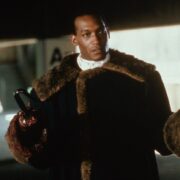Peruse any streamer for Black horror films on Halloween (or any time of the year), and you might notice a good stretch of hit movies from the 1990s: “Vampire in Brooklyn,” “Tales From the Hood,” “Eve’s Bayou,” “Tales From the Crypt: Demon Knight,” “Candyman” and so on. You might also realize that by the end of the decade, their success faded — until 2017’s “Get Out.”
What led to the string of releases in the first place? A number of things, according to Mikal Gaines, an assistant professor of English at the Massachusetts College of Pharmacy and Health Sciences.
For one, by the end of the ’80s, the industry was looking for something a bit fresher and out of the scope of the three big villains in the genre at the time: Jason Voorhees, Freddy Krueger and Michael Myers.
“‘Nightmare on Elm Street’ and ‘Friday the 13th’ have all kind of gotten especially meta at that point,” Gaines said. “So there’s just space for weird stuff to open up and for new mythologies to pop in.”
In comes offerings like 1990’s “Def by Temptation,” directed by James Bond III, which follows a Black succubus (Cynthia Bond) who hunts lascivious Black men. Director Wes Craven, who had been entrenched in the genre long before the ’90s, with hits like the “Nightmare on Elm Street” movies beginning in 1984, centered a young Black hero (Brandon Quintin Adams) in 1991’s creepy “The People Under the Stairs.”
Add to that, in 1992, “Candyman” ignited a whole new franchise with a titular Black villain (Tony Todd). “We’re in a weird moment in the genre when people are prepared to kind of take a lot of chances that they might not necessarily have taken,” Gaines said, “since blaxploitation.”
That seems fair to say. Both eras of Black film also highlighted a social consciousness as well as an investment in more, say, autonomous Black filmmaking. Black horror was an outgrowth of that. Gaines even recalled from his dissertation research some evidence that Miramax had plans to start a subsidiary called Miramax Urban.
“That was supposed to capitalize kind of on the popularity of the hood film and just build on the momentum that Miramax itself had had in steering independent cinema in the ’90s,” Gaines said.
The professor’s research was not clear on why that never quite manifested. But despite the chances studios might have been more willing to take by the start of the decade, he suggested that they took the safer route and also tapped into some established audiences.
Much of the studios’ enthusiasm for films like “Tales From the Hood,” “Vampire in Brooklyn” and many others at the time came down to their understanding that the Black image could be commodified on screen — and that Black audiences would come out for it.
“Something like ‘Tales From the Hood’ is a Black horror movie, but it’s also a hood movie in the middle of the hood boom,” Gaines said. (Movies like “Juice,” “Dead Presidents” and “New Jack City,” for instance, were also all released in the ’90s).
“So they’re making those horror movies, but they’re also these movies that have at least a two-quadrant appeal to Black audiences. Something like ‘Vampire in Brooklyn’ — if you’re a horror movie fan, you’ll probably see it.”
Gaines quickly added: “I think the vast majority of Black audiences are going to go see it because Eddie Murphy and Angela Bassett and Allen Payne are in it.”
And filmmakers such as Rusty Cundieff, who directed 1995’s “Tales From the Hood,” were well aware of all of this. On another video call, he pointed to the industry’s obviously big interest in Black romantic comedies, including “The Best Man” and “The Wood,” at the time.
“So I just think as an offshoot of that, some of the Black horror films — it’s like, Oh, look, we can make money off of Black people,” Cundieff said. “So, well, let’s try it. Let’s put him in some horror, too. What the hell? I don’t know. See what’s gonna happen there, you know?”

That’s frustrating but oh-so-easy to believe. But, to Hollywood’s credit, that was partly because back then there was an actual investment in less-familiar stories and creatives that is practically obsolete today.
“Part of what helped at that point was there were still a lot of companies that felt kind of indie, that would do things that weren’t so big,” Cundieff said, “a point where IP [intellectual property] wasn’t the motivator for most everything.”
Savoy Pictures, the studio behind “Tales,” was that kind of company. But despite its interest in the film, it wanted to control some aspects of the story. That’s partly because the movie, which tells four separate stories, directly portrays issues such as police brutality, Black gang violence, the corrupt political system and domestic abuse in the Black home.
In effect, they were issues that made white audiences uncomfortable or excluded them altogether. They are scenarios inspired by events that especially affected Black lives and made no allowances for whiteness in the wake of the 1992 Los Angeles uprising and the militarized reign of Police Chief Daryl Gates, who, as Cundieff described to me, “turned the LAPD into storm troopers, in a way.”
So Savoy was uneasy with “Tales.” The studio sent the script back to Cundieff and his team with myriad notes. “We’re just like, ‘These are really bad notes.’” The director credits producer Spike Lee for pushing back against the studio.
“As big as he is now, he was probably even more of a 500-pound gorilla then,” Cundieff told me. “We called Spike, and Spike called them on our behalf and said, ‘Leave ’em the fuck alone.’ So, that was that. That was the greatest thing ever.”
There was still the marketing of the film left to do, which could make or break a movie. And Lee wasn’t around to push back when it came to that. As a result, the marketing “was one of the worst things ever,” Cundieff said.
Looking back at the nearly two-minute trailer and having watched the film, the director’s point is well taken. The trailer consists of a quick montage of some of the wildest scenes in the movie — including David Alan Grier’s torso twisted around, a deranged-looking animated Black doll running toward the screen and one character saying incredulously, “This is a trip, homie.”

If you didn’t know any better, you might think the movie boils down to, as the voiceover in the trailer puts it, “tales of madness.” Full stop.
“They were afraid of all the issues,” Cundieff said. “They did not want to position the movie as something that dealt with any type of issue that affected anybody — Blacks or otherwise.”
I tell the director that, actually, every good horror movie — particularly a Black horror movie — has done just that throughout history. The 1968 film “Night of the Living Dead” and 1971’s “Blacula” are just two examples. Those films have gone on to do quite well among a variety of horror fans.
Cundieff thought about that before responding. “I mean, I think we were maybe a bit more blatant in what we were talking about than some of the other previous films. You know, you could look at ‘Blacula’ and ‘Ganja & Hess’ — these kinds of things where we’re talking about something, but it’s not quite as in your face.”
Still, the studios really didn’t have a justifiable reason to be skittish about “Tales” beyond the fact that they were clearly buckling to a social climate in L.A. that was tumultuous at best.
Cundieff recalled going to a test screening for the film in New York that the studio made sure was inclusive (“meaning there were white people there and of different ages, not just twentysomethings or college students,” he clarified). The filmmaker found that the older white audiences especially liked the story in the film about the Black gangbangers.
“Well, because that was us talking about us,” the director said.
Right. He went on to say white audiences also had issues with the episodes in “Tales” where the racist white cops kill the Black man and later get a comeuppance and the one where Corbin Bernsen plays a senator and former Ku Klux Klan member. “For the studio, I think that scared them,” Cundieff said.
It was that kind of fear, though, that catered to a conservative mindset and did “Tales From the Hood” a major disservice with its marketing. While Cundieff and his team were able to make the film they wanted, the film didn’t do as well as it should have at the box office. It opened in the No. 9 spot.

“We are lucky to have come out in the era of VHS then, and then laser discs and DVDs, which allowed it to really get an audience,” Cundieff said. “People that I’d run into after — they’re like, ‘Oh, I saw your thing, finally. If I had known what it was about, I would’ve come.’”
You can tell that still frustrates the filmmaker today, even though “Tales From the Hood” has gone on to be embraced by more audiences on home video and streaming.
A similar issue with marketing happened to 1995’s “Demon Knight,” though that film opened in the third spot at the box office. But you might not know it by the way it was treated.
Shortly after its release, director Ernest Dickerson was reading the Los Angeles Times when he said he stumbled upon a piece about recent films by Black filmmakers and noticed that he wasn’t mentioned at all. Discontented, he decided to contact the reporter about it, particularly since he saw that John Singleton’s “Higher Learning,” which opened in the spot just above his film’s at the box office, was also highlighted in the piece.
“I said, ‘You just did an article on African American filmmakers,’” Dickerson told me on a video call. “‘I’m curious as to why you left me out.’ And she says, ‘Well, you have to understand, I’m doing articles on people that have done something recently, recent filmmakers.’”
The reporter evidently couldn’t quite place how Dickerson was relevant to the piece.
“And I said, ’Well, my film came out and opened up at number [three] — ‘Demon Knight,’” he continued. “She said, ‘Oh, my God, you did ‘Demon Knight?’ I said, ‘Yes. See, you could have had a hell of an article with two films that weekend by African American directors.’”
The thing is, not many audiences even realized that he helmed “Demon Knight” — or that its director was Black. “The fact that I was an African American filmmaker doing this film wasn’t really pushed,” Dickerson said.
Meaning, the studio never marketed the film to Black audiences or as a Black film, even though it has among the first Black final girls in horror (Jada Pinkett Smith as Jeryline), who ultimately defeats a cunning fiend from the underworld. The studio wasn’t even sold on a Black actor in that role in the first place. That was Dickerson’s idea, and he was hellbent on making it happen.

“I always wanted to find a sister who was slight of stature to play Jeryline,” Dickerson told me.
It wasn’t until he saw Pinkett Smith in 1993’s “Menace II Society” that he knew exactly who he wanted in the role. But he knew that a Black final girl would be a tough sell in Hollywood.
“The producers had somebody else entirely different in mind, who was not African American,” he continued. “I arranged a meeting with Jada, and I told her I wanted her to do this film. And she was gonna have to go in and sell herself to Joel Silver, who was one of the producers.”
She did, obviously, which thrilled Dickerson because he, like many audiences, understood the dire circumstances of Black images in horror at the time.
“I wanted to play a trick with the audience because I figured the audience is gonna think she’s probably gonna be one of the first people to die,” he said. “And I figured, we meet her — Oh, she’s demon fodder, you know.”
“But she turns out to be the heroine, the person that actually saves everything,” he beamed in retrospect. “Yeah, I’m happy about that.”
It’s a shame the studio wasn’t as enthusiastic about it, that they didn’t scream that from the rooftops. Because that’s major.
“I find marketing departments at studios are really ignorant in terms of how they market films,” Dickerson said plainly, “especially films with African Americans in them.”
That seems to be a problem that has yet to be rectified today.
I asked Dickerson if he was at least incentivized to make more Black horror films throughout the decade after “Demon Knight.”
“I was definitely trying to. It was always finding the right script. I think I got some slasher scripts, but I’m not into horror for the gore. Gore can be necessary, but it should not be the be all, end all. So I was having a really hard time finding stuff that I really wanted to do.”

At one point, he was attached to the 1998 vampire movie “Blade,” starring Wesley Snipes, but that collaboration ended unceremoniously.
“I think for some reason — I don’t know if ‘Demon Knight’ killed that for me or what,” Dickerson told me. “But they chased me for years. And then when I came up with a concept, which they wound up adopting for the movie, I was dropped.”
He said that so matter-of-factly that I couldn’t figure out how he felt about it. So I asked him.
“Oh, I was pissed off, because it was very underhanded the way it was done.”
After Dickerson’s 2001 horror film “Bones” failed to do well at the box office, again due to the same marketing shortsightedness, studios effectively lost interest in the Black horror film. Others, like “Leprechaun in the Hood” and “Queen of the Damned,” were released in the early aughts, but too few of them had the kind of success that many in the ’90s did.
“It was a fad that — I guess there wasn’t that much that came out that was making money,” Dickerson concluded.
Though dismal box office receipts played a large part in Black horror’s decline, it seemed like that was partly by the studios’ design.
But Gaines questions whether that decline had anything to do with the social consciousness of a lot of Black horror at the time, in part because studios had no problem cashing in on other Black movies that dealt with similar themes on race, such as “Boyz n the Hood” in 1991 and “Menace II Society.”

Dimension Films/Courtesy Everett Collection
“The gatekeepers and the decision-makers at the executive levels in those periods — I’m skeptical of the idea that they care about anything other than what’s profitable,” he said. “I feel when those people are making decisions, they’re like, ‘Does it sell?’”
And truth be told, by the end of the ’90s, Black horror wasn’t selling.
Gaines said that that was also in part because studios realized that it didn’t need to. Because Black horror fans would see any horror movie, no matter if Black folks were in it or not.
That’s what Craven alluded to in the opening sequence of 1997’s “Scream 2.” In it, Maureen and Phil (a Black couple played by Pinkett Smith and Omar Epps) are among a rowdy audience watching a scary movie at the theater when they’re both murdered within the first 15 minutes of the film. Ghostface fatally stabs Phil in the bathroom, then repeatedly impales Maureen in the theater.
Dripping gobs of blood as she stumbles up to the front of the big screen, dying, she screams out to the largely white crowd that looks back at her, unfazed. Whether their indifference to her depleting humanity is because she’s obstructing their favorite movie or because they’re desensitized to images of violence against Black bodies, a crucial fact remains: They’re being entertained.
Gaines remembers watching the movie in theaters with Black friends in South Jersey. They laughed when Maureen meets her maker, much to the confusion of the white folks around them.
“This white kid I remember from my high school sitting in the front row was like, ‘Oh, y’all think that shit is funny?’” he remembered. “And a friend of mine was like, ‘Yeah, that shit is funny.’”

Part of that is because Black fans had kinda always been, as the professor put it, “in on the joke” when it comes to the ways in which our images pop up in the horror genre. We’ll watch horror movies that center Black characters and we’ll also help white horror films that sideline or kill off Black characters in the first act dominate the box office. That long predates the ’90s.
“The kind of meta conversations that emerge around what horror movies are doing to Blackness have always been both part of the frustration but also to some degree part of the fun that Black audiences have watching horror movies,” Gaines said.
And the studios were all too cognizant of that, which contributed to their decreased popularity. “I think they figured out that they could make their money without necessarily having to appeal directly to Black audiences,” Gaines told me.
But that was apparently to the detriment of filmmakers like Dickerson who were trying to continue the legacy of Black horror films at the time.
Nearly two decades had passed before Black horror would experience another heyday, beginning with 2017′s “Get Out,” which spawned a string of similarly confrontational Black horror films that did well at the theater and even earned awards.
“The inside joke for horror scholars is that horror is always saving the industry in some ways,” Gaines said. “Because it is the one genre that, regardless of whatever else is going on, performs and is not especially costly to make, in a lot of cases.”
That tracks with what Cundieff told me. “Tales” was shot using practical effects and was non-union “except for actors and stuff,” he said. It also had a budget of only $6 million.
Horror, Gaines continued, “has been what that the industry has turned to, to keep the money coming in.”
Apparently that is until it no longer serves them, or if it was never really set up to succeed in the first place.











Comments